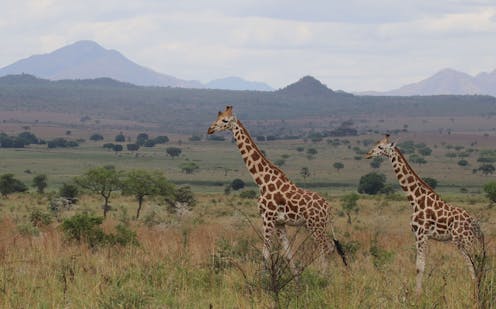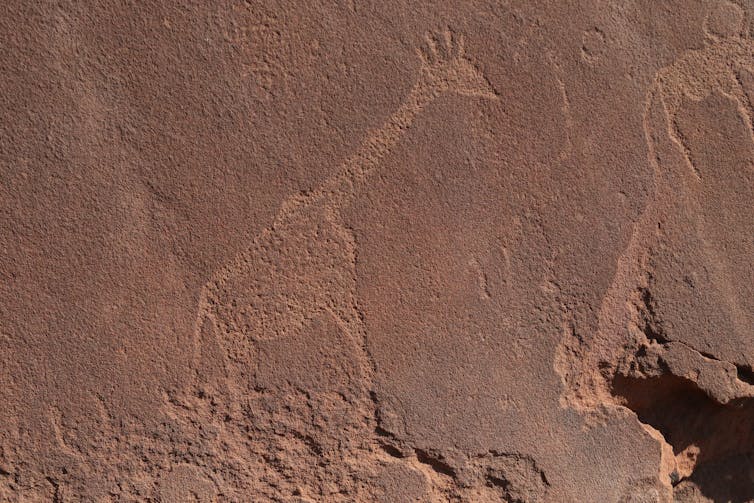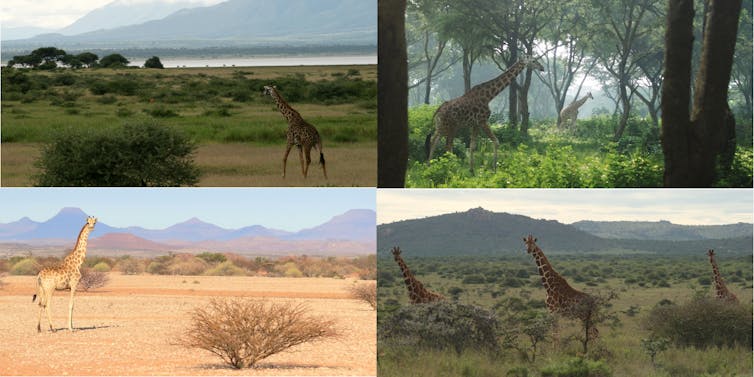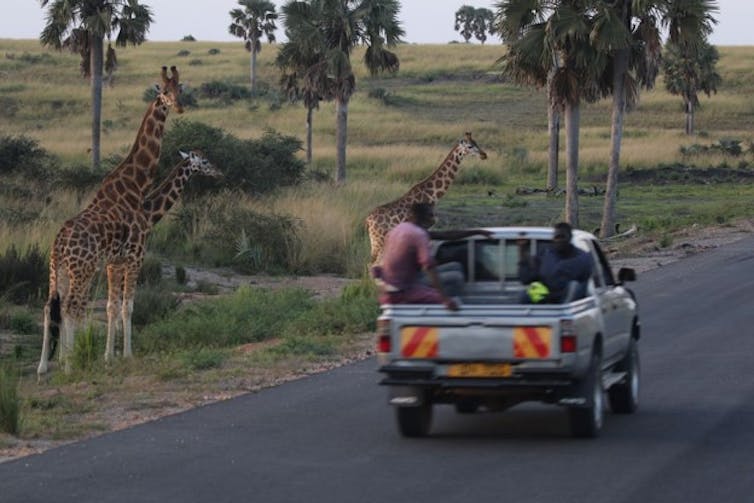
Nearly 6,000 years ago, our ancestors climbed arid rocky outcrops in what is now the Nigerian Sahara and carved spectacularly intricate, larger-than-life renditions of giraffes into the exposed sandstone. The remarkably detailed Dabous giraffe rock art petroglyphs are among many ancient petroglyphs featuring giraffes across Africa – a testament to early humans’ fascination with these unique creatures.
We are still captivated by giraffes today, but many of these animals are at risk, largely due to habitat loss and illegal hunting. Some are critically endangered.
To understand how giraffes are faring across Africa, conservation ecologists like me are studying how they interact with their habitats across vast geographic scales. We use space-age technology and advanced statistical approaches that our ancient ancestors could have scarcely imagined to understand how giraffes can better coexist with people.

Many habitats and challenges
Giraffes may all look similar to the casual viewer, but in fact there are four distinct species. By our best estimates, there are roughly 117,000 giraffes remaining in the wild, living in 21 African countries.
Across this huge expanse, giraffes make their homes in many different environments with varied levels of human influence. For example, in the relatively arid Sahel region of Niger, they live among communal farmers entirely outside of formally protected areas. In contrast, along the Nile in Uganda’s national parks, they browse through lush savannas that are formally protected by dedicated rangers.
Each of these areas has unique bioclimatic conditions and conservation philosophies. There is no one-size-fits-all approach for protecting giraffe habitats and promoting coexistence with people.
Researchers are taking advantage of these diverse conditions to learn how giraffes move throughout this range. In a recently published paper, I worked with colleagues from academia and conservation organizations to conduct the largest ever tracking study to better understand how and why giraffes move at large scales.

Tracking wide-ranging animals
Over the past decade, our collaborative conservation research team, spearheaded by the Giraffe Conservation Foundation, has embarked on an ambitious pan-African giraffe-tracking study to better understand giraffes’ movements across these diverse landscapes.
Each tracking operation contributes to local studies by telling us something interesting about giraffe behavior. For example, we published the first description of partial migration in a Ugandan giraffe population, showing that giraffes can have complicated seasonal movements.
These studies also are important for guiding local management of giraffes. Partnering with organizations like EarthRanger, which develops software to support conservation initiatives, we have pioneered the use of animal movement data to inform active conservation management.
We share giraffe location data in real time with rangers in protected areas to guide day-to-day conservation actions. As an example, we run continuous analytics on the giraffe data that alert teams on the ground when a giraffe stops moving or leaves the boundaries of a national park. With this information, teams can follow up quickly and address risks, such as when giraffes might be straying into dangerous areas.
To look at these patterns at a larger scale in our recent study, we analyzed GPS tracking data from 148 giraffes, representing all four species from across 10 countries. We wanted to understand how giraffes may change their movements in response to human pressures and the availability of vegetation.
We used environmental data from satellite imagery, linking the giraffes’ locations to the exact conditions that the animals were moving through. Since the work drew from information collected across Africa through different GPS devices, we developed statistical techniques to harmonize the datasets and make the results directly comparable across ecosystems.
Overall, we found that giraffes cover impressively large areas. On average, each animal has a home range of about 140 square miles (360 square kilometers) – nearly equivalent to the surface area of Philadelphia – and travels about 8.5 miles (14 kilometers) every day. One of the biggest movers in our study, a female northern giraffe in Niger that navigated among communities raising livestock in the dry Sahel, covered a home range of nearly 1,500 square miles (3,860 square kilometers) – larger than the land area of Rhode Island.
Giraffes’ movements changed significantly based on the availability of woody vegetation and the level of human presence. Those in areas with plenty of woody vegetation didn’t cover as much ground as their counterparts in more barren zones, since the former had most of the resources they needed close by. Giraffes also tended to move less in places with significant human development – probably because of man-made barriers to their movements, like settlements, fences and roads.
In mixed areas with some development and some open spaces, we observed that giraffes covered more ground as they navigated these patchy environments. They traveled faster and covered larger areas when they were moving between resource-rich zones and more heavily developed areas.

Giraffe movements inform conservation
Understanding how giraffes respond to changes in environmental conditions is critical for their conservation. Climate change is making the availability of vegetation less predictable, and human populations in these areas are continuing to grow. Conservation strategies will need to account for giraffes’ changing movements as the animals respond to these shifts.
It also is important to develop principles for giraffe movement so that we can better predict how they might move in new environments. Conservation groups and governments are increasingly using conservation translocations – capturing wild giraffes and moving them to new habitats – as a tool to reestablish populations in areas where giraffes had previously become extinct.
Our movement data from giraffes across Africa is casting new light on their responses to different conditions and providing important information for conserving these iconic animals in a rapidly changing world.
Michael Brown works for the Giraffe Conservation Foundation and is an affiliated researcher for the Smithsonian National Zoo and Conservation Biology Institute. He receives funding from the Giraffe Conservation Foundation and its many supporters and is affiliated with the Smithsonian National Zoo and Conservation Biology Institute.
This article was originally published on The Conversation. Read the original article.







